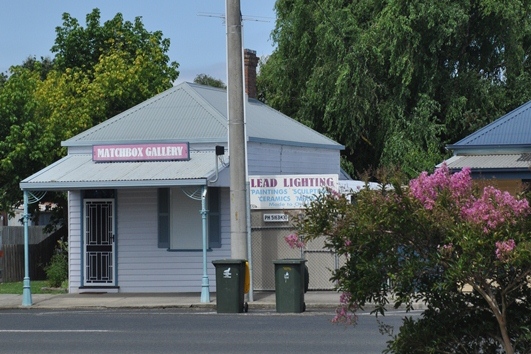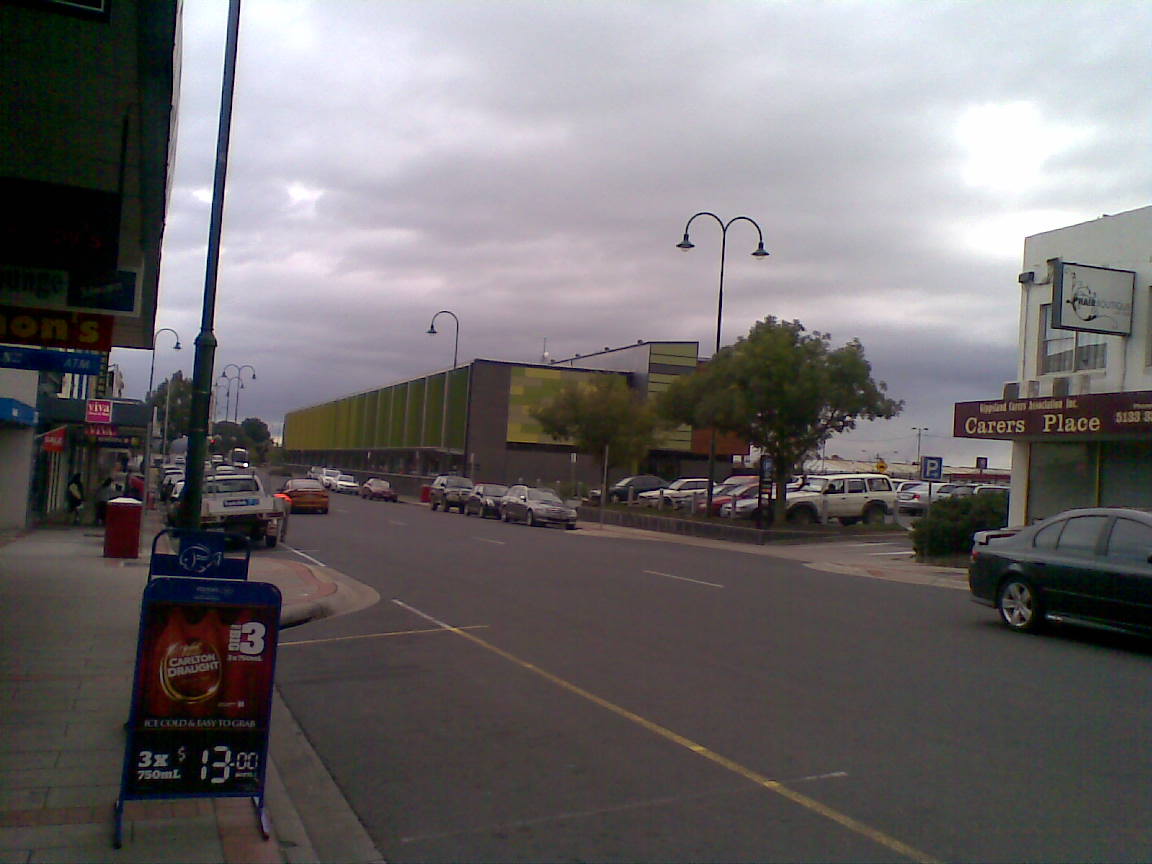|
Yinnar South
Yinnar South is a small rural town in the Latrobe Valley in Victoria, Australia. According to the 2015 Latrobe Community profile page and Census quickstats, Yinnar South has a population between 686 and 691. This data is taken from 2016 Census night. Previous higher figures were from Census 2006 and incorrectly combined both Yinnar and Yinnar South due to Census data compiled from postal area as opposed to geographical reference. The first school in Yinnar South, School No. 2730, was opened 11 January 1886. It currently operates as a primary school. Henry Collins set up his saw mill in Mill Road c. 1911 and built a tramline along Whitelaw's Track. The town has a small church, approximately four metres by five metres, known as Holy Innocents. It was built in 1894 by James Mortan and painted by John Curtie. The church was licensed on 1 January 1895. Mortan built eight pews for the church as a gift; they remain in use. A small porch was later added to the building. The church i ... [...More Info...] [...Related Items...] OR: [Wikipedia] [Google] [Baidu] |
Yinnar South School 1914
Yinnar is a rural Australian township located in the Latrobe Valley in central Gippsland, Victoria. At the 2016 census, Yinnar had a population of 907. The origin of the name "Yinnar" is believed to have been derived from the local Aboriginal term ''yinnar'', meaning "woman". History Yinnar began as a part of the Scrubby Forest Station at Middle Creek, which as its name implies, was heavily wooded. Its southern section was mountainous, so its area of practical use was estimated as ten square miles. The first holders were Nicol Brown and Billy Hillier. Eventually they divided the station into two with Middle Creek being the line of division, Brown taking the western half and Hillier the eastern half. Billy's Creek was named after Billy Hillier. They held their leases from 1848 to 1868. George Firmin arrived at Middle Creek in 1874 and took over Scrubby Forest West, which he divided into what was known as the Scrubby Forest Run. Due to this the Firmin family are said to be the fi ... [...More Info...] [...Related Items...] OR: [Wikipedia] [Google] [Baidu] |
Yinnar South Grants Saw Mill 1908
Yinnar is a rural Australian township located in the Latrobe Valley in central Gippsland, Victoria (Australia), Victoria. At the 2016 Australian Census, 2016 census, Yinnar had a population of 907. The origin of the name "Yinnar" is believed to have been derived from the local Indigenous Australians, Aboriginal term ''yinnar'', meaning "woman". History Yinnar began as a part of the Scrubby Forest Station at Middle Creek, which as its name implies, was heavily wooded. Its southern section was mountainous, so its area of practical use was estimated as ten square miles. The first holders were Nicol Brown and Billy Hillier. Eventually they divided the station into two with Middle Creek being the line of division, Brown taking the western half and Hillier the eastern half. Billy's Creek was named after Billy Hillier. They held their leases from 1848 to 1868. George Firmin arrived at Middle Creek in 1874 and took over Scrubby Forest West, which he divided into what was known as the Sc ... [...More Info...] [...Related Items...] OR: [Wikipedia] [Google] [Baidu] |
Latrobe Valley
The Latrobe Valley is an inland geographical district and urban area of the Gippsland region in the state of Victoria, Australia. The traditional owners are the Brayakaulung of the Gunai nation. The district lies east of Melbourne and nestled between the Strzelecki Ranges to the south and the Baw Baw Ranges, part of the Great Dividing Range, to the north. Mount St Phillack () is the highest peak to the north of the Latrobe Valley, due north of Moe. The highest peak to the south is Mt Tassie (), south of Traralgon. The area has three major centres, from west to east, , Morwell and Traralgon, with minor centres including , , , and . The population of the Latrobe Valley is approximately 125,000. The valley draws its name from the Latrobe River which flows eastward, through the valley. According to Les Blake, in 1841 William Adams Brodribb, an early settler, named the river in honour of Charles La Trobe, Lieutenant Governor of the Port Phillip District. A. W. Reed also attr ... [...More Info...] [...Related Items...] OR: [Wikipedia] [Google] [Baidu] |
Victoria, Australia
Victoria is a state in southeastern Australia. It is the second-smallest state with a land area of , the second most populated state (after New South Wales) with a population of over 6.5 million, and the most densely populated state in Australia (28 per km2). Victoria is bordered by New South Wales to the north and South Australia to the west, and is bounded by the Bass Strait to the south (with the exception of a small land border with Tasmania located along Boundary Islet), the Great Australian Bight portion of the Southern Ocean to the southwest, and the Tasman Sea (a marginal sea of the South Pacific Ocean) to the southeast. The state encompasses a range of climates and geographical features from its temperate coastal and central regions to the Victorian Alps in the northeast and the semi-arid north-west. The majority of the Victorian population is concentrated in the central-south area surrounding Port Phillip Bay, and in particular within the metropolitan area ... [...More Info...] [...Related Items...] OR: [Wikipedia] [Google] [Baidu] |
Morwell
Morwell is a town in the Latrobe Valley area of Gippsland, in South-Eastern Victoria, Australia approximately 152 km (94 mi) east of Melbourne. Morwell has a population of 14,389 people at the . It is both the seat of local government and administrative centre for the City of Latrobe. Morwell is located in the centre of the Latrobe Valley urban area, which has a population of 77,168 at the 2021 Census and is home to many of the greater urban area's civic institutions, administrative functions and infrastructure. The city is known for its role as a major energy production centre for Victoria as the centre of a major coal mining and fossil-fuel power generation industry. Morwell's centenary rose garden located in the central business district, won an award in 2009 for being a 'garden of excellence'. Since 2018, the town has hosted the International Rose Garden Festival Morwell (IRGFM). Naming The name of the town of Morwell is likely to be derived from a local In ... [...More Info...] [...Related Items...] OR: [Wikipedia] [Google] [Baidu] |
Primary School
A primary school (in Ireland, the United Kingdom, Australia, Trinidad and Tobago, Jamaica, and South Africa), junior school (in Australia), elementary school or grade school (in North America and the Philippines) is a school for primary education of children who are four to eleven years of age. Primary schooling follows pre-school and precedes secondary schooling. The International Standard Classification of Education considers primary education as a single phase where programmes are typically designed to provide fundamental skills in reading, writing, and mathematics and to establish a solid foundation for learning. This is ISCED Level 1: Primary education or first stage of basic education.Annex III in the ISCED 2011 English.pdf Navigate to International Standard Classification of Educati ... [...More Info...] [...Related Items...] OR: [Wikipedia] [Google] [Baidu] |
Dicksonia Antarctica
''Dicksonia antarctica'', the soft tree fern or man fern, is a species of evergreen tree fern native to eastern Australia, ranging from south-east Queensland, coastal New South Wales and Victoria to Tasmania. Anatomy and biology These ferns can grow to in height, but more typically grow to about , and consist of an erect rhizome forming a trunk. They are very hairy at the base of the stipe (adjoining the trunk) and on the crown. The large, dark green, roughly-textured fronds spread in a canopy of in diameter. The shapes of the stems vary as some grow curved and there are multi-headed ones. The fronds are borne in flushes, with fertile and sterile fronds often in alternating layers. The "trunk" of this fern is merely the decaying remains of earlier growth of the plant and forms a medium through which the roots grow. The trunk is usually solitary, without runners, but may produce offsets. They can be cut down and, if they are kept moist, the top portions can be replanted and ... [...More Info...] [...Related Items...] OR: [Wikipedia] [Google] [Baidu] |
Towns In Victoria (Australia)
This is a list of locality names and populated place names in the state of Victoria, Australia, outside the Melbourne metropolitan area. It is organised by region from the south-west of the state to the east and, for convenience, is sectioned by Local Government Area (LGA). Localities are bounded areas recorded on VICNAMES, although boundaries are the responsibility of each council. Many localities cross LGA boundaries, some being partly within three LGAs, but are listed here once under the LGA in which the major population centre or area occurs. The Office of Geographic Names (OGN), led by the Registrar of Geographic Names, administers the naming or renaming of localities (as well as roads, and other features) in Victoria, and maintains the Register of Geographic Names, referred as the VICNAMES register, pursuant to the ''Geographic Place Names Act 1998''. The OGN has issued the mandatory ''Naming rules for places in Victoria, Statutory requirements for naming roads, features ... [...More Info...] [...Related Items...] OR: [Wikipedia] [Google] [Baidu] |







